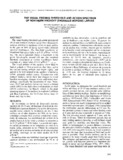The visual feeding threshold and action spectrum of northern anchovy (Engraulis mordax) larvae
- Global styles
- MLA
- Vancouver
- Elsevier - Harvard
- APA
- Help

URL ที่เชื่อมโยง
calcofi.orgวันที่
1983Page views
1,888ASFA keyword
เมตาดาต้า
แสดงระเบียนรายการเต็ม
Share
นามธรรม
The visual feeding threshold and action spectrum of 10-15-mm northern anchovy larvae were determined, using as criterion the incidence of two or more rotifers in the guts of 50% of larvae tested under different spectral irradiances. The threshold sensitivity ot broadbank blue-green light is at 0.15 µWcm-2=0.61 lux. The action spectrum shows a mixumum in the green wavelengths around 530 nm: the weighted threshold irradiances at various wavelength bands converge at a mean value of 0.14 µWcm-2anch eff.
The visual abilities of the anchovy allow them to feed at a depth of 74 m at noon on clear days, and at the surface during twilight and bright nights, and appear to be well adapted to the anchovy's habitat in turbid, greenish coastal waters. Comparisons with younger anchovy larvae show that changes in visual function accompany changes in eye and retinal morphology, specifically the recruitment of rods. Moreover, 10-15-mm anchovy larvae can feed to a limited extent (10%) in the dark when food densities are high (20-40 rotifers/ml). In March, which is the peak spawning season of the anchovy in southern California and Baja California, the 10-15-mm larvae have 13 hours each day to feed.
การอ้างอิง
Bagarinao, T., & Hunter, J. R. (1983). The visual feeding threshold and action spectrum of northern anchovy (Engraulis mordax) larvae. California Cooperative Oceanic Fisheries Investigations Reports , 14(24), 245-254. http://hdl.handle.net/10862/1131
Type
ArticleISSN
0575-3317คอลเลกชัน
- Journal Articles [1256]


